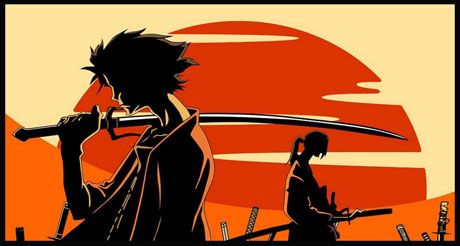
When Cowboy Bebop concluded in 1998, viewers waited eagerly to see what Shinichiro Watanabe would do next. After directing two short films for the anthology feature The Animatrix in 2003, he released the broadcast series Samurai Champloo in 2004. It was worth the wait.
Although it was a science fiction series about a “space cowboy”/bounty hunter, Bebop offered a jazz-inflected, alienated homage to the great film noir movies. Champloo (which comes from the Okinawan word for “stew”) is an edgy, anachronistic mix of violent martial arts combat, slapstick comedy, period adventures and hip-hop irreverence.

A brawl in a rural tea house brings together three misfits in Edo-era Japan. Rebellious and rude, Mugen (Steve Blum) sports a mop of frizzy hair, earrings and tattooed wrists and ankles. Swap his getta for the latest Nikes and he could star in YouTube videos. When he fights, he incorporates break dance spins and flips, which confuse his opponents, who expect the disciplined movements of a trained martial artist.
In contrast to the rowdy Mugen, the ronin Jin (Kirk Thornton) embodies the icy discipline of the ideal samurai. Every movement is calculated, practiced and polished. In combat, he suggests a dancer performing a deadly recital. Mugen brags about his low-life lack of ethics; Jin lives by a rigid code of honor.
In return for helping them escape execution, Fuu (Kari Wahlgren), a waitress from the tea house, demands Jin and Mugen stop fighting until they’ve helped her find an unnamed samurai “who smells of sun flowers.” Initially, the ditsy Fuu seems like comic relief, but as the series progresses, she reveals unexpected depths and complexities.
Although Champloo is set in the mid-17th century, the stories abound with offbeat anachronisms. When a US clipper ship arrives more than a century before Commodore Perry, a nascent crisis over trade gets resolved in a baseball game. Abner Doubleday makes a surprise appearance–almost 100 years before his birth. Mugen wins a place in sports history as the first man to pitch a no-hitter in getta. In other episodes, characters carry boom box-like cases and rap into microphones long before electricity reached Japan.
“I’ve been interested in hip-hop since it first appeared: the fact that it was born not in the music industry but on the street, the idea of using a turntable as an instrument, singing vividly about reality instead of typical love songs, and its links to graffiti and dance,” Watanabe said in an email interview. “I believe samurai in the Edo period and modern hip-hop artists have something in common. Rappers open the way to their future with one microphone; samurai decided their fate with one sword.”

Watanabe’s interest in hip-hop is showcased in Episode #18. While Mugen gets belatedly reading lessons from an angry elementary school teacher, Jin attempts to settle the rivalry between twin brothers who inherited his former instructor’s dojo. The result is an outrageous graffiti contest that features Tokugawa-era rap lyrics, ink-brush tagging, Hiroshima homeboys and a clothing designer who’s a caricature of Andy Warhol. Only Watanabe could blend these anachronistic hijinks seamlessly.
But Champloo has a darker side: “The series also deals with ethnic and racial discrimination in Japan,” Watanabe added. “In addition to Okinawans and the way they’ve been persecuted by mainland Japanese, there are episodes about the Ainu, a gay man from the Netherlands, and Christians, who were persecuted during the Tokugawa era.”
As an outlaw and a native of Ryuku, Mugen is doubly an outsider in 17th century Japanese society. Watanabe plays his childhood flashbacks against an Okinawan folk song to stress the character’s alienation. Fuu, Mugen and Jin risk execution to escort gay Dutch trader Izaak Titsingh on a tour of Edo. Izaak tries to pass himself off as Japanese–despite his red hair, blue eyes and Ah-nold-esque accent. At the Kabuki theater, he falls in love with an onnagata, a male actor who plays female roles.
Fuu’s search for the mysterious “Sunflower Samurai” takes the trio to the southern island of Kyushu–and into the smoldering animosities left by the Shimabara Rebellion of 1637-38. They find themselves caught up in the Tokugawa persecution of the remaining Christians in Japan, which precipitates the violent final story arc.
Like Cowboy Bebop—and all Watanabe’s other series—the last episode of Samurai Champloo leaves the viewer unhappy to see the story end. Mugen, Jin and Fuu are interesting, complex characters who could easily share additional adventures. But unlike many American animators, who keep bringing back characters long after they’ve worn out their welcome, Watanabe knows it’s better to leave the audience wanting more.
Samurai Champloo: The Complete Series
Funimation: $49.98, 3 discs Blu-ray
- Charles Solomon’s Animation Year End Review 2023 - December 28, 2023
- INTERVIEW: Makoto Shinkai on “Suzume” - November 27, 2023
- Interesting Portrayals of Gay Men in Manga/Anime - June 12, 2023


 March 4th, 2019
March 4th, 2019  Charles Solomon
Charles Solomon  Posted in
Posted in  Tags:
Tags: 






